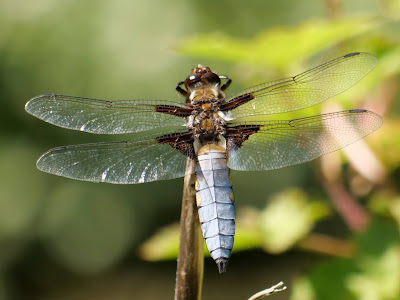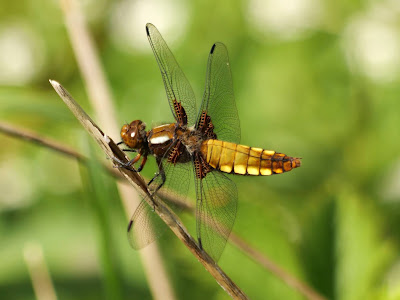Pond life
I'm a big fan of ponds. Even a tiny pond can support a huge amount of life. This is the best time of year to see life in ponds, at the start of the breeding season. The great thing about ponds is that while at first glance you may not see anything, stay still and watch for a few minutes and you may spot the golden eyes of frogs peering at you from just above the surface, or newts popping up for air.
This post is about some of the living creatures that live in or visit ponds. I won't cover waterfowl like ducks, geese and swans here, I'm focusing on the less visible creatures. At the end, I've listed some of the ponds locally which are good for wildlife.
Common frogs
 |
| Frog, Littleheath Woods, Feb 2021 |
Most people are familiar with frogs and their spawn, which they lay in large clumps. Frogs spend the winter hibernating in damp places, such as under piles of leaves, mud or logs. In early spring, they emerge and head for ponds, where they mate and lay spawn.
Gradually the individual tadpoles in the spawn begin wriggling and hatch after several weeks. It takes 3-4 months for the tadpoles to grow into froglets and most of them don't make it. Frogs' reproductive strategy is the opposite of humans' - they are r-strategists, meaning that they put the effort into having as many young as possible and then leave them to it, so most of the tadpoles sadly won't make it to adulthood - if they did, we'd be overrun with frogs.
The tadpole below was caught accidentally while I was cleaning duckweed and algae out of the pond. You can see its front legs starting to grow. I put it back in straight after taking the photo.
When froglets leave the pond, they are still tiny. You may see them from June onwards.
 |
| Froglet, July 2020 |
The adult frogs spend quite a lot of time away from the pond feeding on insects, worms, slugs and snails, so you may see them in your garden even if you don't have a pond. They tend to play dead when spotted, or jump with a splash into the pond at the first sign of disturbance.
Newts
 |
| Newt, Lloyd Park, April 2020 |
The main newts around here tend to be smooth newts. They're smaller than frogs and large numbers of them can be seen in some ponds. They can vary in appearance depending on their sex and the time of year, with the males sporting a wavy crest along their backs during the breeding season. Both sexes are brown with orange bellies and black spots. Female newts lay eggs individually on aquatic plant leaves, which take around 2-3 months to become tiny adult newts.
 |
| Two young newts, still with external gills |
When they're still in the larval stage, they have external gills so they can breathe under water, and they remind me of miniature axolotls. Newts are a predator of tadpoles and water snails, plus on land they eat insects, slugs and worms.
Great Crested Newts are a rare species with special protection and it's illegal to disturb them. Sadly I'm not aware of any in Croydon but they have been found at sites just over the border in Surrey.
Toads
 |
| Common toad at Sutton Ecology Centre, Carshalton, July 2013 |
Common toads look like frogs but wartier and they walk, rather than jump. You may find them in your garden hiding in damp, dark places. They eat slugs and snails. They tend to breed in larger, deeper ponds than frogs, and rather than clumps, they lay their eggs in strings between underwater plants.
I don't have any photos of toads in Croydon but in the photo below, taken at Bramley Bank nature reserve, there's toad spawn in strings on the left of the two frogs.
Dragonflies and damselflies
Dragonflies and damselflies are beautiful, ancient insects, which swoop and hover in the air around ponds and perch on vegetation. Damselflies tend to be smaller than dragonflies and they hold their wings together at rest, whereas dragonflies spread theirs out.
 |
| Male Broad-Bodied Chaser (dragonfly), Lloyd Park, May 2020 |
Dragonflies have eyes which take up much of their heads, giving them excellent vision, which they use to hunt smaller insects on the wing.
 |
| Female Broad-Bodied Chaser, Lloyd Park, May 2020 |
The below insect is a female Beautiful Demoiselle, a fitting name for this type of damselfly, which I spotted last July on the River Wandle in Beddington, just outside of Croydon. The Beautiful Demoiselle and Banded Demoiselle are the only damselflies with coloured wings.
Damselflies, and sometimes dragonflies, can be seen flying around or perched on water attached to each other in their mating position, in the spring and summer.
 |
| Large red damselflies mating, Lloyd Park, April 2020 |
Fertilised eggs are laid in water or in underwater vegetation and hatch the following spring.
 |
| Dragonfly nymph in a pond just outside Croydon, May 2020 |
The nymphs then spend several years underwater, catching smaller insect larvae, aquatic invertebrates, tadpoles and even small fish. When they're ready to leave the water, they climb up a plant stalk and the adult dragonfly gradually emerges from the shell of the nymph. They pump haemolymph (blood) into their body and wings and flap their wings to warm up so they can fly. They leave their empty larval shell behind and these can sometimes be seen.
Dragonflies and damselflies can sometimes be seen away from water - last summer I saw some at the top of Croham Hurst.
 |
| Large red damselfly on Croham Hurst |
Other pond visitors
Birds use ponds to wash and drink and it is fascinating watching them. Many song birds such as goldfinches fly down in small flocks and take turns at keeping watch while the others bathe.
Mammals such as foxes, hedgehogs, badgers and deer use ponds to keep hydrated and some people have cameras set up by their garden ponds which capture great footage and photos of wildlife drinking and bathing.
Where to find pond life in the Croydon area
Build it and they will come!
If you have your own garden, it's easy to put in a small pond which will be able to support a wide variety of creatures. The Wildlife Trusts website has a guide to digging a pond, or if you only have a small space, you can put in a mini pond using a bucket, plant pot or old washing up bowl.
There are larger ponds and lakes around but it can be harder to spot pond life in them, so most of the sites below are small ponds.
Lloyd Park pond
This fairly small pond is located near the Deepdene Avenue entrance and supports a large population of newts in the summer. It is also used by dragonflies and damselflies for breeding. Birds such as goldfinches, dunnocks and blue tits bathe and drink in the pond and the stream behind it. There is a new interpretation board.
Heathfield Gardens
There are several ponds near the house and some small wildlife ponds in the Ecology Centre orchard, when it's open. The ornamental pond either side of the wooden bridge are popular with newts and the slightly higher up pool often gets frogspawn.
Bramley Bank
The edges of the large pond here support frog and toad spawn.
Littleheath Woods
There are several ponds here, with the keyhole pond in the corner near Selsdon town centre supporting lots of frogs (see the photo at the top of the page) and the round pond next to Fallen Oak Field supporting a range of wildlife.
Waddon Ponds and Sanderstead Pond
Look around the shallow edges of the ponds for tadpoles in spring.
Wandle Park
The pond supports a wide range of wildlife, look from the pond dipping platform and around the reeds.
Coombe Wood
The fish in the main pond make it unsuited to tadpoles but the smaller pools higher up the rockery are popular with bathing birds and visiting dragonflies.
The following sites have small wildlife ponds:
- Whitehorse Meadow
- Addiscombe Railway Park
- Beaulieu Heights
- Threehalfpenny Wood
- Kings Wood
- Selsdon Wood (in the fenced Jubilee Plantation but visible from outside)
These ponds are fenced off but visible from the pavement:
- Whitgift Pond on Mapledale Avenue (near Lloyd Park)
- Beulah Hill Pond













Comments
Post a Comment